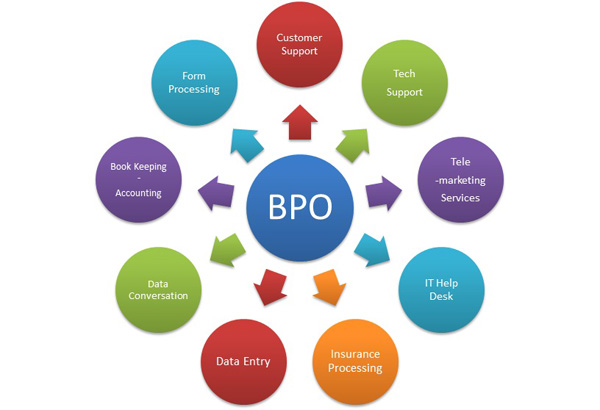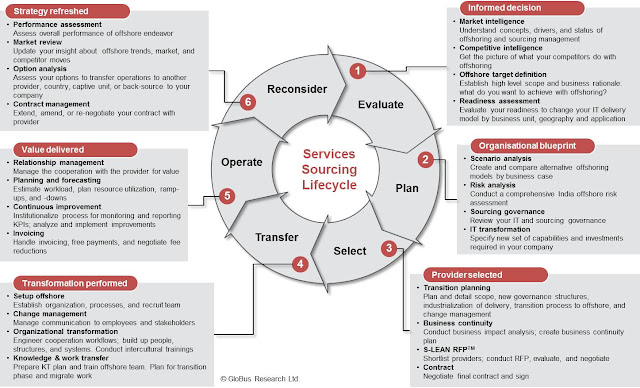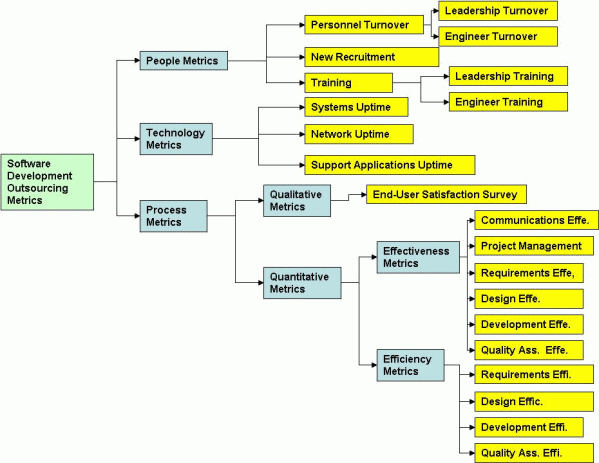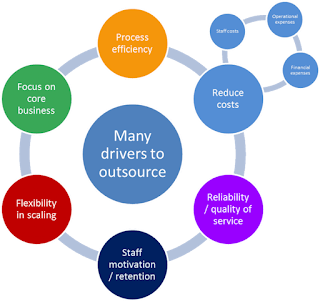Dear visitor,
Here I would like to introduce with you an Aboriginal concept newly that is BPO which abbreviation Business Process Outsourcing .

Concept on BPO
This refers to outsourcing that involves the contracting of the operations and responsibilities of a specific business process to a third-party service providers.
Nowadays, BPO is identified with the process of sending work functions to companies and individuals located in foreign countries. The most all known countries in the terms of BPO are India, Philippines and China.
At present outsourcing becomes an unavoidable part of corporate business strategy, maily when economic is in downturns, BPO (Business Process Outsourcing) has flowed out as an important tool of IT Enabled Services. In very recent years, it has improved from being considered for limited peripheral activities to enclosed very critical business activities that contribute to strategic advantage.

Tools of BPO
How to succeeding in BPO:
For succeeding with Business Process Outsourcing (BPO), you have to find out and determine if outsourcing should be pursued at all. This phase is known as the Assess phase as the involved parties first try and establish senior stakeholder expectations here. At the end of this phase, stakeholders should have achieved clarity on the expected benefits, costs and risks of the potential engagement at the business.

Process of BPO
Next is the Prepare phase which enclosed the vendor selection process. Most of the organizations roll out RFPs (Request for Proposal) documents through which parties try to find the right outsourcing partner. Fundamental elements of all other phases are defined and agreed upon in this Phase.

Service Outsourcing Life-cycle
After the prepare phase parties forward to the Evaluate phase which is the third stage of the outsourcing life cycle and it focuses on structured and thorough evaluation of the proposals received from vendors or partners. At last you should enable to negotiate with selected vendors.
At this stage paves the way for the Commit phase which is essentially the pre-contract stage. The Commit phase is by far the most resource intensive and commercially ultimate phase as the deal design is finalized and the transition plan is developed in this phase.
Next goes phase 5 which is the Transition and Transform phase. At this phase, a robust transition plan is implemented and involved high business risks also. In addition, a reporting mechanism through the formal documentation is also brought in place at this stage of the outsourcing life cycle.
Now the Optimize phase focuses on managing the vendor relationship efficiently, tracking the vendor fees against the original proposal and monitoring contractual obligations, it will be a strong bonding in business if everything is as per the party expectations. In principal, this phase is an ongoing one until the contract is renewed, renegotiated or exited.

Metrics of Outsourcing
When implemented properly, outsourcing contracts are likely to be inadequate benefits on organizations. No wonder that BPO (Business Process Outsourcing) is considered as a disruptive force that has huge impact on the cost-structure of nearly any industry and that's why it is not easy for organizations to ignore it.
The 4 biggest risks you face when outsourcing
The following sections discuss the various outsourcing risks which must be examined within the course of a make or buy decision:
1. Supplier risk
Any arrangement with suppliers has elements of risk involved it; however, risks related to sourcing internationally are often higher. With sourcing, the corporate must thoroughly investigate (i.e. perform due diligence on) potential source markets and suppliers, making an in-depth risk assessment and checking the business practices of potential suppliers to spot any possible problems. Issues to research are outlined below.
2. Quality
The implications of a top quality failure from a world source are far more severe than a top quality failure from a domestic source. With the lead times involved transporting goods from international sources, serious disruptions can occur and it can take several months to rectify the matter . to assist minimize this risk, many companies prepare detailed product specifications for suppliers and demand on independent internal control inspections.
See the subsequent Case Study in quality control: Some years ago, a small U.S. company obtained a contract to provide character dolls for a famous entertainment conglomerate. The proprietor found a supplier in China that offered excellent pricing and showed pictures of samples that they had produced to specifications provided. Because the availability contract was vital for this and future business, the proprietor decided to go to the plant, where he found that the samples were the sole suitable models of the many the manufacturer had produced.
The proprietor decided to remain at the plant to supervise the whole six week production run. the top result was a successful, high margin transaction with a satisfied buyer and lots of other similar contracts to follow. Summers in Southern China, product ready for Christmas!
3. property protection
When companies share information with suppliers in countries that have less stringent regulations about property rights, proprietary information is typically leaked. for a few products this might constitute an insurmountable obstacle to outsourcing. In others, where the merchandise is consistently evolving, the corporate may plan to dispense with patent protection, confident it can develop new products faster than the market can reverse engineer them.
4. Reputational Risk
To avoid negative impact on the name , supplier human rights issues (e.g. hiring underage workers, poor treatment, and environmental violations) must be carefully investigated to make sure compliance with the company’s code of conduct. Other important considerations with global sourcing include the following:
☑ Transport time, costs and risks are usually above with domestic sourcing as a consequence of the longer routes;
☑ Cultural differences may complicate business communications or cause shipping delays;
☑ Documentation for international sourcing is complicated and should require research, consulting costs or in many cases outsourcing to a brokerage;
☑ Supplies could be interrupted by political instability, requiring identification of other sources; and,
☑ Weather might be an element , creating shipping delays. Ideally, to attenuate their risk exposure to the above factors, companies should investigate a balanced sourcing strategy during which a mix of worldwide and domestic sources are used.

Risk Factors of Outsourcing and Remedy Factors
The Secrets of Cost Optimization in Outsourcing
It’s a scenario that few would relish. You’re a serious telecom player with a first-generation outsourcing deal, and you're undergoing a huge cost-cutting program to drive down operational expenditure. you're locked into a long-term contract that has little room to maneuver, with the provider refusing to return to the negotiating table unless you comply with combat an enhanced portfolio of services. The pricing model is bundled, and therefore the provider is reluctant to share any pricing details.
It seems like a situation but, during this instance, the client involved undertook an indoor assessment with a consultant so as to know the extent to which costs might be negotiated with the provider. an in depth “deal sheet” was prepared containing various items that needed an instantaneous fix — keeping in sight both the long-term relationship and costs. Some tough negotiations around various failures ensued, and helped to bring the provider to the table.
“Cost optimization shouldn't be a one-off response to a difficult situation.”
“The bottom line is that the deal sheet helped drive the negotiations,” said DD Mishra, research analyst at Gartner. “Cost and various other challenges under the contract became a part of the discussion. apart from the prices , a variety of governance and operational issues — also as contractual ambiguity — were also negotiated to pave the way for a healthy relationship.”
While this might be an honest example of how sourcing managers can drive down costs and maximize optimization, Mr. Mishra maintains that cost optimization should be an ongoing tactic, not a one-off response to a difficult situation.
“Faced with ongoing pressure to try to to more with less, sourcing managers got to constantly review the challenges facing their organizations and make sure that their contracts reflect these realities,” he said.
Mr. Mishra outlined three key challenges that sourcing managers face in implementing cost optimization initiatives, and the way they could be overcome:
Challenge 1: Organizations often don't build into their contracts effective benchmarking terms or other key cost-optimization mechanisms to drive continuous cost improvement over the terms of a contract.
Sourcing managers got to include market benchmark terms in contracts, and embed scope-change options to leverage falling per-unit prices resulting from automation or efficiency improvement.
Challenge 2: Many outsourcing contracts don't leave mitigated currency risk as they use U.S. dollars, allowing providers to require advantage of currency fluctuations and making the service expensive when the dollar is stronger than the delivery country’s currency.
Evaluate the pros and cons of deals in local currency versus U.S. dollars, using historical currency fluctuation data. When possible, avoid currencies that have a risk of getting stronger. Consider options like hedging, or eliminate cost-of-living adjustments to stop any losses from the currency fluctuations.
Challenge 3: Outsourcing contracts generally have a three- to five-year term, and don't include the power to adopt new sourcing options like cloud services, automation or advanced concepts associated with IoT that drive cost efficiency and value.

Sourcing managers need to build into the contracts the expectation that providers will deliver between 4 and eight percent year-over-year productivity with innovative sourcing models. they have to figure with the provider and business to use asset-light services (such as infrastructure as a service, software as a service, and business process as a service), remote infrastructure management, offshoring and automation to drive down costs over the term of the contract.











